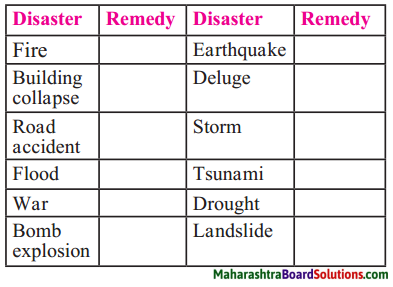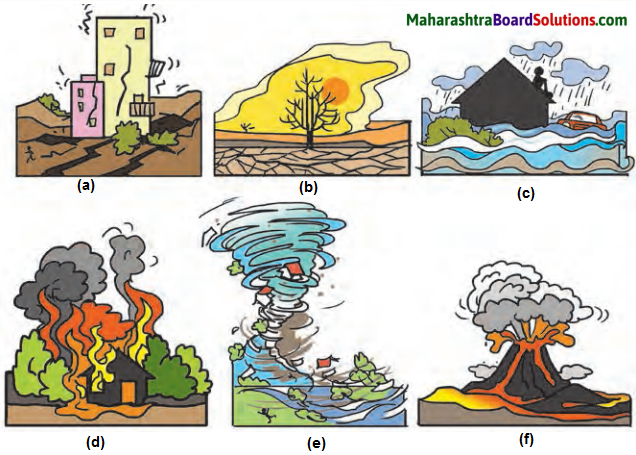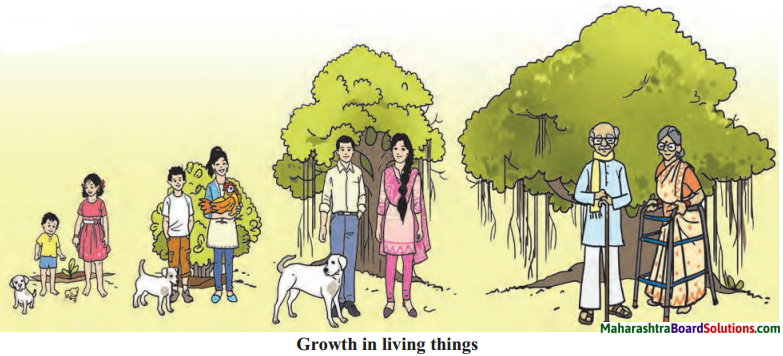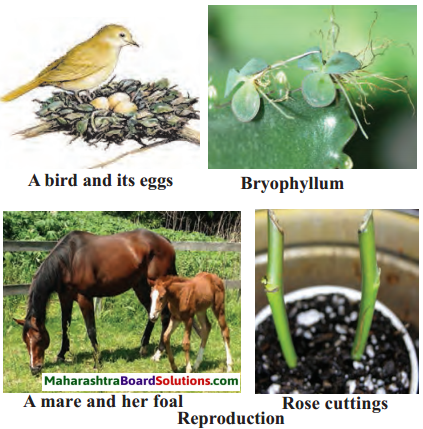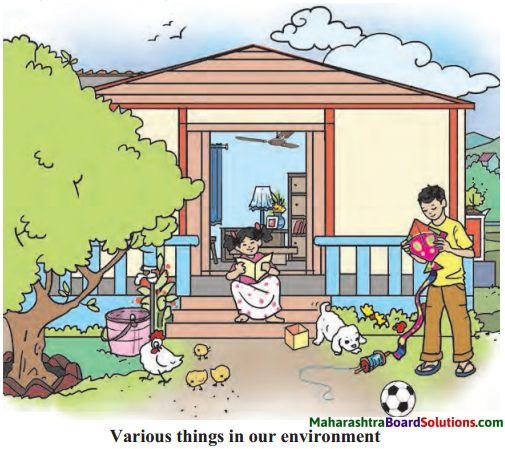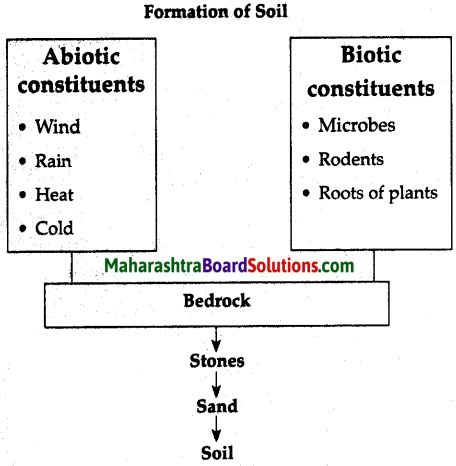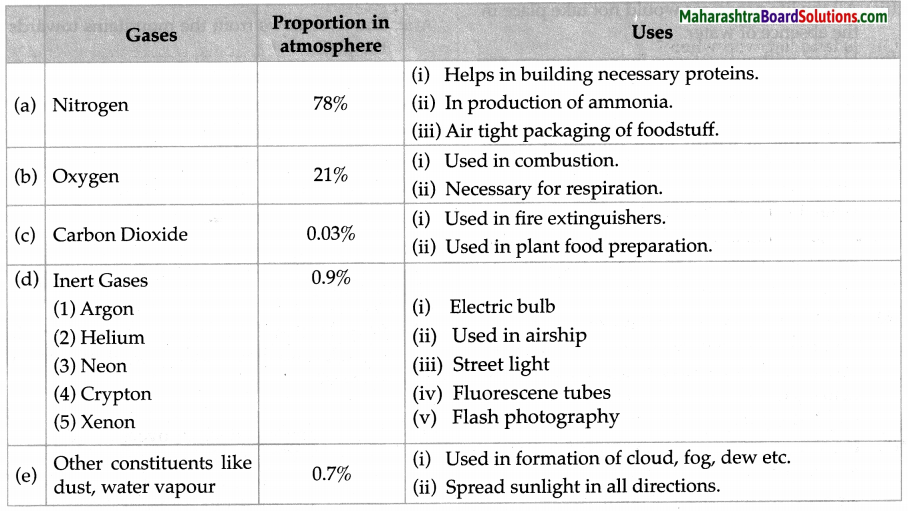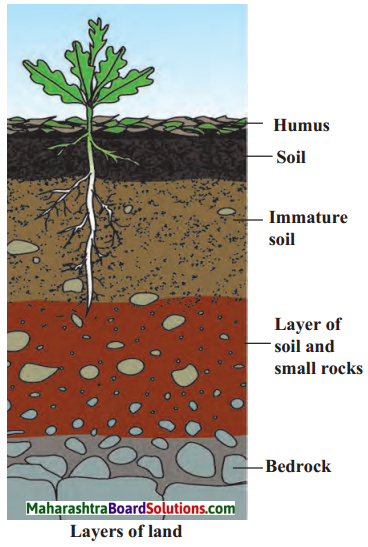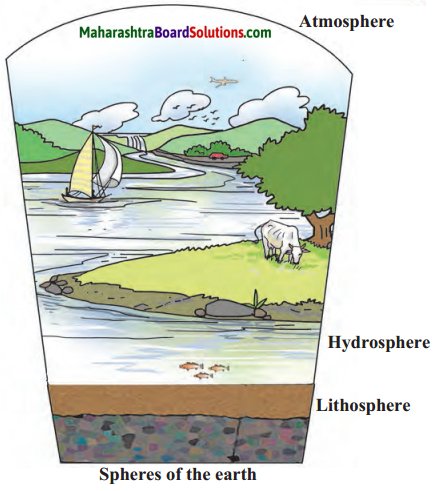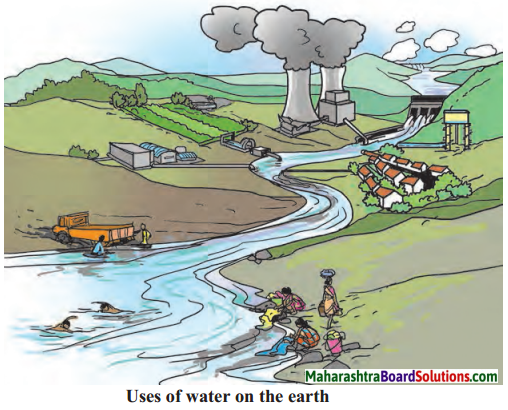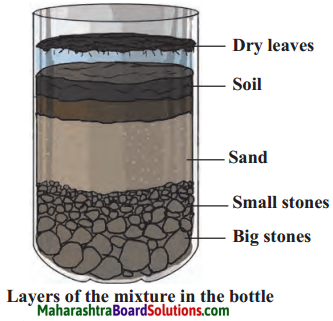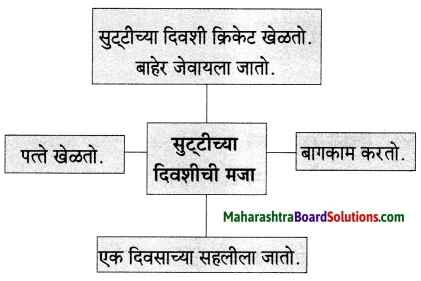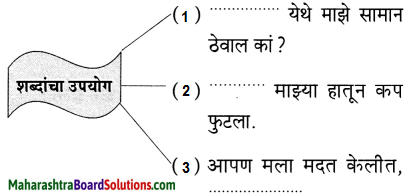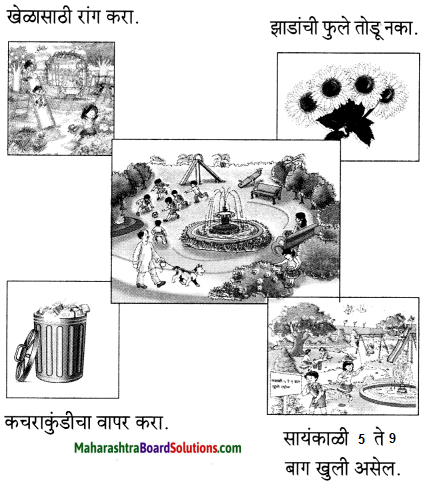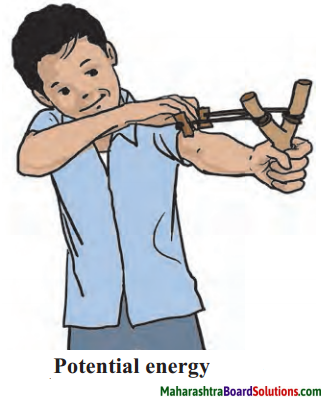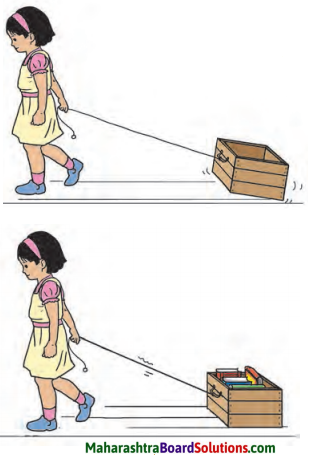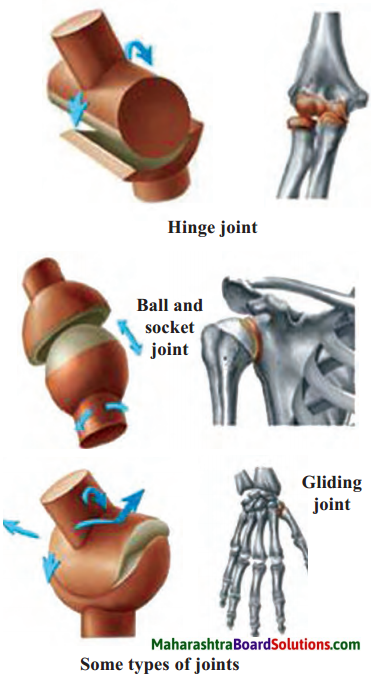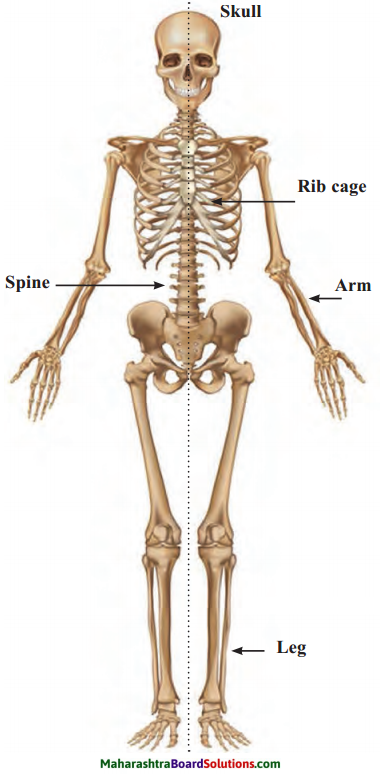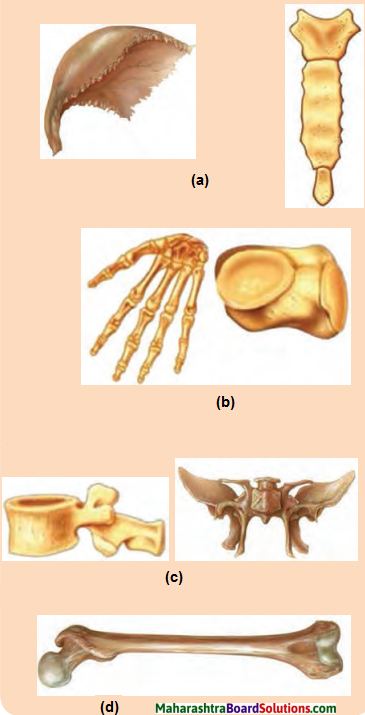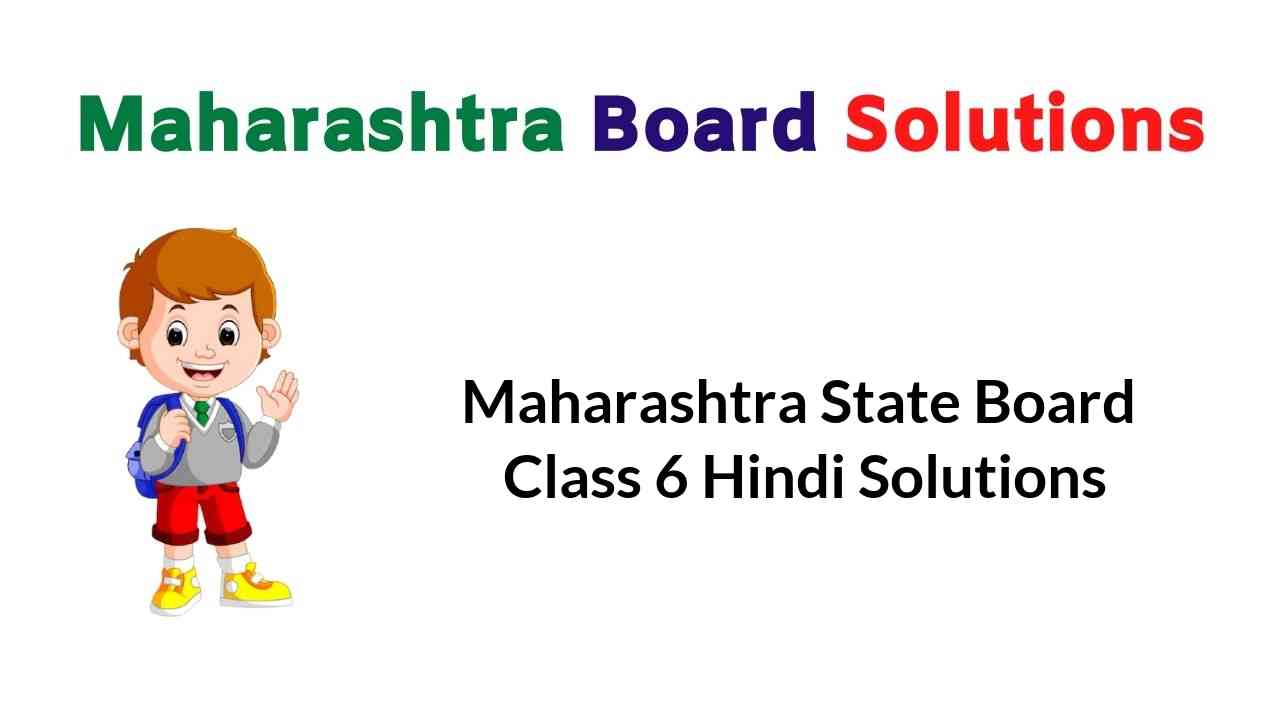Balbharti Maharashtra State Board Class 6 Science Solutions Chapter 16 The Universe Notes, Textbook Exercise Important Questions and Answers.
Maharashtra State Board Class 6 Science Solutions Chapter 16 The Universe
Class 6 Science Chapter 16 The Universe Textbook Questions and Answers
1. Name these.
Question a.
Birthplace of stars.
Answer:
Nebulae
Question b.
The biggest planet in the Solar System.
Answer:
Jupiter

Question c.
The galaxy which is our neighbour.
Answer:
Andromeda
Question d.
The brightest planet in the solar system.
Answer:
Venus
Question e.
Planet with the largest number of satellites.
Answer:
Jupiter
Question f.
Planet without a single satellite.
Answer:
Venus and Mercury
Question g.
Planet with a rotation different from other planets.
Answer:
Venus

Question h.
A celestial body that carries a tail along.
Answer:
Comet
2. Fill in the blanks.
Question a.
The group of galaxies of which our Milky Way is a part is called ………….. .
Answer:
Local group
Question b.
Comets are made of ………… .
Answer:
ice and dust particles
Question c.
The planet ……………… appears as if it is rolling along its orbit.
Answer:
Uranus
Question d.
…………….. is a stormy planet.
Answer:
Jupiter

Question e.
The pole star is the best example of a ………………. type of star.
Answer:
variable
3. Say if the statements given below are right or wrong. Rewrite the statements after correcting them.
Question a.
Venus is the planet closest to the sun.
Answer:
Wrong: Mercury is the planet closest to the sun.
Question b.
Mercury is called a stormy planet.
Answer:
Wrong: Jupiter is called a stormy planet.
Question c.
Jupiter is the biggest planet.
Answer:
Right
4. Answer the following.
Question a.
What is a special characteristic of the planet Mars?
Answer:
The highest and the longest mountain in the solar system ‘Olympus Mons’ is located on Mars.

Question b.
What are the type of galaxies?
Answer:
The different types of galaxies identified according to their shapes are spiral, elliptical, barred spiral, irregular.
Question c.
Which celestial bodies does a galaxy include?
Answer:
Galaxy includes stars, their planetary system, cluster of stars, nebulae, clouds of gases, clouds of dust, dead stars, newly bom stars etc.
Question d.
Name the different types of stars.
Answer:
The different types of stars are
- Sun-like stars e.g. stars like Sirius, Alpha Centauri
- Red Giants Stars
- Super Nova
- Binary or Twin Stars
- Variable Stars e.g. Polaris (pole star)
Question e.
What are the types of comets and on what basis are they classified?
Answer:
- Comets are of two types: Long-period comets and short-period comets.
- Classification of comets is based on the time (period) taken by the comets to complete one revolution around the sun.
Question f.
What is the difference between meteors and meteorites?
Answer:
- Meteors are rocky pieces originating from the asteroid belt. Smaller rocky pieces get completely burnt due to friction with air after they enter the earth’s atmosphere.
- Meteors which do not bum completely and fall to the surface of the earth are called meteorites.

Question g.
What are the characteristics of the planet Neptune?
Answer:
Neptune is the eighth planet in the solar system. A season on Neptune lasts for about 41 years. On this planet winds blow with extremely high speed.
5. Match the following.
Question a.
| Group ‘A’ | Group ‘B’ |
| 1. Galaxy | (a) From east to west |
| 2. Comet | (b) 33 satellites |
| 3. Sun-like star | (c) Spiral |
| 4. Saturn | (d) Sirius |
| 5. Venus | (e) Halley |
Answer:
| Group ‘A’ | Group ‘B’ |
| 1. Galaxy | (c) Spiral |
| 2. Comet | (e) Halley |
| 3. Sun-like star | (d) Sirius |
| 4. Saturn | (b) 33 satellites |
| 5. Venus | (a) From east to west |
Activity:
Question 1.
Using the material you can find in your house, prepare a model of the solar system.
Question 2.
Collect information about different aspects of each planet such as its distance from the sun, its diameter, its volume, etc. and present it in a science exhibition.
Class 6 Science Chapter 16 The Universe Important Questions and Answers
Fill in the blanks.
Question 1.
The Milky Way is known as ………….. .
Answer:
Mandakini

Question 2.
The ………….. is a galaxy in which our solar system is located.
Answer:
Milky Way
Question 3.
The galaxy that is closest to our Milky Way is ………….. .
Answer:
Andromeda
Question 4.
The universe includes innumerable galaxies, the space between them and also ………….. .
Answer:
energy
Question 5.
The Milky Way is a part of the ………….. of galaxies.
Answer:
Local group
Question 6.
Generally, the surface temperature of stars ranges from 3500° C to ………….. .
Answer:
50000°C
Question 7.
The colour of stars changes according to their ………….. .
Answer:
temperature

Question 8.
Red giants stars are ………….. in colour.
Answer:
red
Question 9.
Super Nova stars are ………….. and ………….. than the red giant stars.
Answer:
brighter, larger
Question 10.
More than ………….. of the stars in the sky are ………….. stars.
Answer:
half, binary
Question 11.
The ………….. and ………….. of variable stars is not stable.
Answer:
luminance, shape
Question 12.
When a star contracts, its surface temperature ………….. and the star emits ………….. energy and appears ………….. .
Answer:
increases, greater, brighter
Question 13.
The sun which is at the centre of the solar system is a ………….. coloured star.
Answer:
yellow

Question 14.
The diameter of the sun is approximately ………….. km.
Answer:
13, 92, 000
Question 15.
………….. is the fastest moving planet.
Answer:
Mercury
Question 16.
………….. is the brightest planet in the solar system.
Answer:
Venus
Question 17.
………….. is the hottest planet.
Answer:
Venus
Question 18.
As the earth is a ………….. there is a magnetic field around the earth.
Answer:
magnet
Question 19.
Mars is also called the ………….. .
Answer:
Red planet

Question 20.
As the soil on Mars contains ………….. its colour is reddish.
Answer:
iron
Question 21.
………….. planets of the size of the earth can get accommodated on Jupiter.
Answer:
1397
Question 22.
Jupiter is called as ………….. .
Answer:
The stormy planet
Question 23.
Saturn mass is ………….. times that of the earth.
Answer:
95
Question 24.
………….. cannot be seen without a telescope.
Answer:
Uranus

Question 25.
Winds blow with extremely high speed on ………….. .
Answer:
Neptune
Question 26.
………….. is the satellite of the earth.
Answer:
The moon
Question 27.
The moon’s period of ………….. and ………….. are both of 27.3 days.
Answer:
rotation, revolution
Question 28.
………….. is classified as a dwarf planet.
Answer:
Pluto
Question 29.
Pluto takes ………….. years to complete its revolution around the sun.
Answer:
248

Question 30.
………….. are formed out of ice and dust particles.
Answer:
Comets
Question 31.
………….. lake in Maharashtra has been formed by the impact of such a meteorite.
Answer:
Lonar
Can you tell?
Question 1.
Which celestial bodies form the solar system?
Answer:
Sun, the eight planets – Mercury, Venus, Earth, Mars, Jupiter, Saturn, Uranus, Neptune, their satellites, Dwarf planets, asteroids, meteors and comets all together form our solar system.

Question 2.
What is the difference between stars and planets?
Answer:
| Stars | Planets |
| 1. Stars are the celestial bodies which can emit heat and light continuously. | 1. The celestial bodies which revolve around the sun in certain orbit are called planets. |
| 2. Stars twinkle in the sky. | 2. Planets do not twinkle in the sky. |
| 3. They have their own light. | 3. They do not have their own light. |
| 4. They are fixed at a point. | 4. They revolve around the sun. |
| 5. They are very big in size. | 5. Planets are small as compared to |
Question 3.
How many planets are there in our solar system?
Answer:
There are 8 planets in our solar system.
Question 4.
What is to be found between Mars and Jupiter?
Answer:
A belt of celestial bodies called as asteriods is found between the planets Mars and Jupiter.

Question 5.
Have you ever seen in the evening or in the pre-dawn hours a large celestial body with a long tail? What is it called?
Answer:
Yes, it is a comet – a large celestial body with a long tail. I have not seen it, but heard that in 1986 there was a Halley’s comet seen in the Indian sky.
Use your brain power!
Question 1.
Why do we see only one side of the moon?
Answer:
As the moon revolves around the earth it also rotates around itself. The moon takes 27.3 days to complete one revolution around the earth. It takes the moon the same time to complete one rotation around itself. Therefore, only one side of moon is visible.
Question 2.
Which planet has a day longer than its year?
Answer:
A planet’s day is how long it takes to complete one rotation on its own axis. Venus takes 243 earth days to complete one rotation because of its slow rotation around its axis. A year is the time taken by the planet to complete one revolution around the sun. Venus completes one revolution around the sun in 225 days. This makes a day longer than a year on Venus.
Answer in one sentence.
Question 1.
What is the Milky Way?
Answer:
Milky way is the galaxy in which our solar system is located.

Question 2.
What is a galaxy?
Answer:
A group of innumerable stars and their planetary systems are together known as galaxy.
Question 3.
What does the Universe include?
Answer:
The universe includes innumerable galaxies, the space between them and also energy.
Question 4.
What different colours do the stars radiate?
Answer:
The stars radiate different colours such as blue, white, yellow and red.
Question 5.
Where are stars bom?
Answer:
The birth place of stars are the huge nebulae, made of dust particles and gases.

Question 6.
What is the surface temperature of the sun?
Answer:
The surface temperature of the Sim is around 6,000°C.
Question 7.
What is the size of the sun?
Answer:
The size of the sun is so huge that around 13 lakh planets of the size of the earth can be easily placed within it.
Question 8.
How does the sun balance the other celestial bodies?
Answer:
Due to the gravitational force of the sun, the celestial bodies in the solar system revolve around it.
Question 9.
How does the sun move in the Milky Way?
Answer:
The sun rotates around its axis and while doing so, it revolves around the centre of the Milky Way taking the solar system along with it.
Question 10.
Which planet doesn’t have atmosphere?
Answer:
Mercury doesn’t have atmosphere.

Question 11.
How much time does the earth take to complete one rotation and one revolution?
Answer:
The earth completes one rotation in 24 hrs and one revolution in 365 days i.e. 1 year.
Question 12.
Which planets have rings around them?
Answer:
Jupiter, Saturn, Uranus, Neptune have rings around them.
Question 13.
Which planet do not have rings around them?
Answer:
Mercury, Venus, Earth and Mars do not have rings around them.
Question 14.
State two properties of planet Mercury.
Answer:
Mercury is the closet planet to the Sim. Mercury is the fastest moving planet.
Question 15.
When is the Mercury visible to us?
Answer:
Mercury is visible in the morning and in the evening if it is away from the sun.

Question 16.
What is seen on the surface of the mercury?
Answer:
A number of depressions which are actually caused by meteoric falls are seen on the surface of mercury.
Question 17.
When is Venus seen in the sky?
Answer:
Venus is seen in the sky in the east before the sunrise and in the west after the sunset. It rotates around itself from east to west.
Question 18.
How does earth protect us from harmful rays of Sun?
Answer:
As the earth is a magnet there is a magnetic field around the earth. It diverts the harmful rays from the sun towards the polar regions of the earth.
Question 19.
What is Olympus Mons?
Answer:
Olympus Mons is the highest and longest mountain in the solar system located on Mars.

Question 20.
Which is the largest planet of the solar system?
Answer:
The Jupiter is the largest planet of the solar system.
Question 21.
Why is Saturn considered a peculiar planet?
Answer:
Saturn considered a peculiar planet because of the rings around it.
Question 22.
How is the axis of Uranus?
Answer:
Uranus axis is so greatly inclined that it appears as if it is rolling along on its axis.
Question 23.
How are seasons on Neptune?
Answer:
The seasons on Neptune last for about 41 years.

Question 24.
What is a satellite?
Answer:
The celestial bodies that revolve around a planet , without independently revolving around the sun are called Satellite.
Question 25.
What is an Asteroid?
Answer:
A great number of small sized bodies could not turn into planets when the solar system was formed, but continued to revolve around the sun. This bodies are known as asteroids.
Question 26.
What is a Dwarf Planet?
Answer:
A small sized celestial body that revolves independently around the sun is called the dwarf planet.
Question 27.
What is a comet?
Answer:
A comet is a celestial body that revolves around sun. Comets are formed out of ice and dust particles.

Question 28.
What are meteors?
Answer:
Meteors are rocky pieces originating from the asteroids belt.
Question 29.
What are meteorites?
Answer:
Meteors which do not bum completely and fall to the surface of the earth are called meteorites.
Give reasons for the following.
Question 1.
Comets came to be called ‘dirty snowballs’.
Answer:
Comets consist of an icy cluster of various constituents like dust particles. Hence it is called dirty snowballs.

Question 2.
Comets are visible when they are close.
Answer:
Comets are formed out of ice and dust particles. They appear like points when they are far away from the sun, but when they are close to the sun they become easily visible to us because of the shorter distance and the heat of the sun.
Question 3.
Comets appear to have a long feathery tail.
Answer:
Comets are made up of frozen matter and dust particles. When they are close to the sun this frozen matter gets converted into gas due to the solar heat. These gases get thrown in a direction away from the sun. As a result comets appear to have a long feathery tail.
Question 4.
Pluto is called as a dwarf planet.
Answer:
Pluto is a small sized celestial body that revolves independently around the sun.
Question 5.
Moon is a satellite of the earth.
Answer:
Moon revolves around the earth without independently revolving around the sun. Hence moon is a satellite of the earth.

Question 6.
Mars is called the Red Planet.
Answer:
As the soil on the Mars contains iron its colour is reddish. Hence Mars is also called the RedPlanet.
Question 7.
Jupiter is called the Stormy Planet.
Answer:
Jupiter revolves around itself with a great speed. Hence Jupiter is called the Stormy planet.
Question 8.
Uranus appears rolling along on its orbit.
Answer:
Uranus axis is so greatly inclined that it , appears as if it is rolling along on its orbit.
Question 9.
Saturn is considered to be a peculiar planet.
Answer:
- Saturn is considered as peculiar planet because of its rings around it.
- Though its mass is 95 times that of the earth, its density is very low.
- If it were dropped into a large sea enough to hold it, it would float in it.
![]()
![]()
